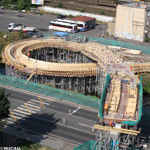Bílina pedestrian bridge
A winding route across the river
Great aluminum shoring system GASS speeds up bridge constructionIn the 19th century, as the railway was built in the cities, stations were erected where squares used to be, mainly around the core cities. From then on, the Bílina River has separated the Bílina city center and the railway station. The European road E442 running along the river additionally contributes to isolate these two areas of the city from each other. A new construction was designed to remedy this situation.
Since September 2010, a gently winding pedestrian bridge extends across the river and the road and provides a link between the city center and the station area. The bridge is already an integral part of the city pedestrian routes. Architecture and urban planning went hand in hand yielding a very successful result.
Bílina (Bohemia, Czech Republic)
The project was already a challenge starting from the first design: a 130 m long pedestrian bridge, with winding bends at different grades, stretching 10 m high across a road and a river. The rugged topography featuring a mainly smooth watercourse with sudden torrential waters involving a risk of flooding added to the requirement of causing the least possible traffic disruption.
The Municipality of the small town of Bílina located about 15 km linear distance from the German border and the Ore Mountains awarded the contractor, Betonstav (Teplice), with the realization of this outstanding task.
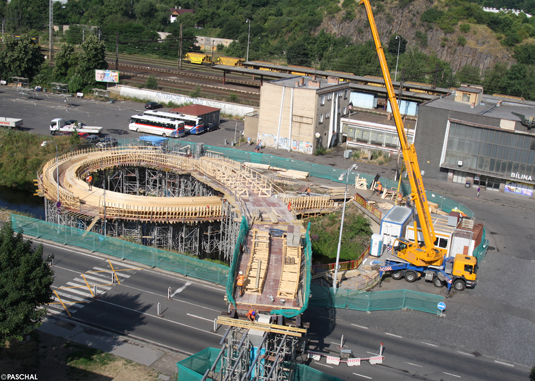
The belt system winds slowly from the train station square, across the river and the multi-lane European Road into the Bílina city centre.
Formwork design
The Czech company PASCHAL s.r.o. (Prague) took over the formwork works. The parent company in Steinach (Baden) assumed the tender preparation, designed all relevant technical solutions and supplied the Great aluminium shoring system called GASS. PASCHAL Prague supplied both wall and slab formwork and was responsible for supervision and technical services.
The bridge piers were casted with LOGO.3 panels. The rough terrain around the river required the building contractor to be extremely flexible.
Throughout the entire length of 130 m, the bridge was completely supported by the GASS shoring system. The GASS Great aluminum shoring system by PASCHAL is the most cutting-edge aluminum shoring system available on the market. With an admissible capacity of up to 140 kN per leg, this system ranks among the highest capacity aluminum structures and even exceeds many steel systems. A stiffing frame forming a tower structure assures 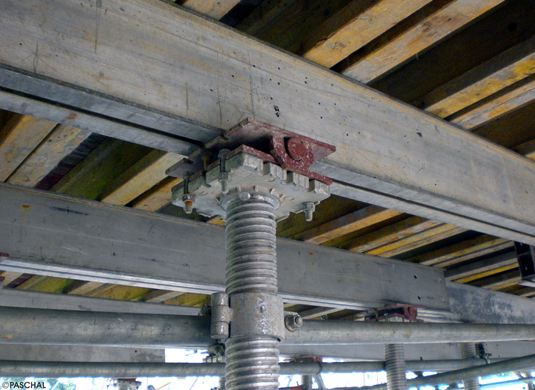 the stability of the system. The nearly round section of the legs provides an optimal static shape capable of taking up large stress forces with a reduced use of material. Two identical base and top plates provide a perfect match and accurate connection of their non-slip, textured surface. A spindle system (height adjuster) is used to safely and quickly erect the shoring up to the design height. On rough terrains and different end levels, a height adjuster can be fitted at each leg end.
the stability of the system. The nearly round section of the legs provides an optimal static shape capable of taking up large stress forces with a reduced use of material. Two identical base and top plates provide a perfect match and accurate connection of their non-slip, textured surface. A spindle system (height adjuster) is used to safely and quickly erect the shoring up to the design height. On rough terrains and different end levels, a height adjuster can be fitted at each leg end.
As compared to other systems, a smaller number of legs and other system components are required, which translates into time saving during assembly and dismantling. The reduced self-weight and the relatively light installation of the shoring assembly allow easy and fast handling making the GASS system better than other comparable products.
Due to the uneven ground conditions of Bílina, this system proved its efficacy and special benefits allowing punctual up and down adjustments both to the terrain and the overhead bridge structure.
The shoring system was replaced by long steel beams under the bridge portion where the bridge forms a loop curving over on itself to pass over the river three times. . The beams stretching over the entire bridge span were laid on two cross members supported by GASS tower structures.
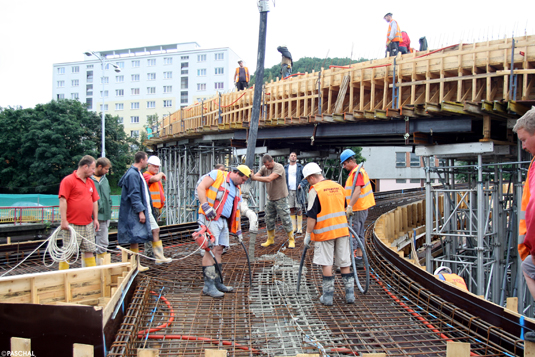
No supporting tower structure can be erected where the road passes over itself. In this case, tower structures are replaced by longitudinal steel elements placed across the span to accommodate the working load.
GASS Great aluminium shoring system is light and easy to handle providing for very rapid erection and dismantling.
The bridge is a massive concrete structure cast in situ and with a flat T-section. H20 wooden girders were used as foundation substructure for the construction work of the carpenters.
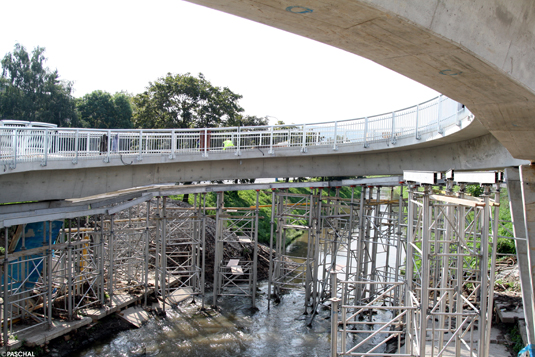
The formwork was removed after the installation of the guardrail assembly. The GASS system was kept in place to support the concrete structure for a few days till the concrete was completely set and when the bridge achieved a full self-bearing structural feature.
A disaster was avoided
On July 23rd, high water (1.5 m above the normal level) threatened to undermine and draw away a number of legs although they were standing on concrete platforms individually laid in the river. The rapid intervention of the company Betonstav saved the situation and succeeded in avoiding a disaster.
Construction works were completed as scheduled. The shell construction amounted to approximately 27 million Czech Crones (1 million Euro). The bridge raised very rewarding comments in terms of both architectural and construction techniques aimed at providing a user-friendly structure also and especially for wheelchair users.
The bridge was inaugurated on September 30th, 2010 and has become a fully integrated part of the city of Bílina.





